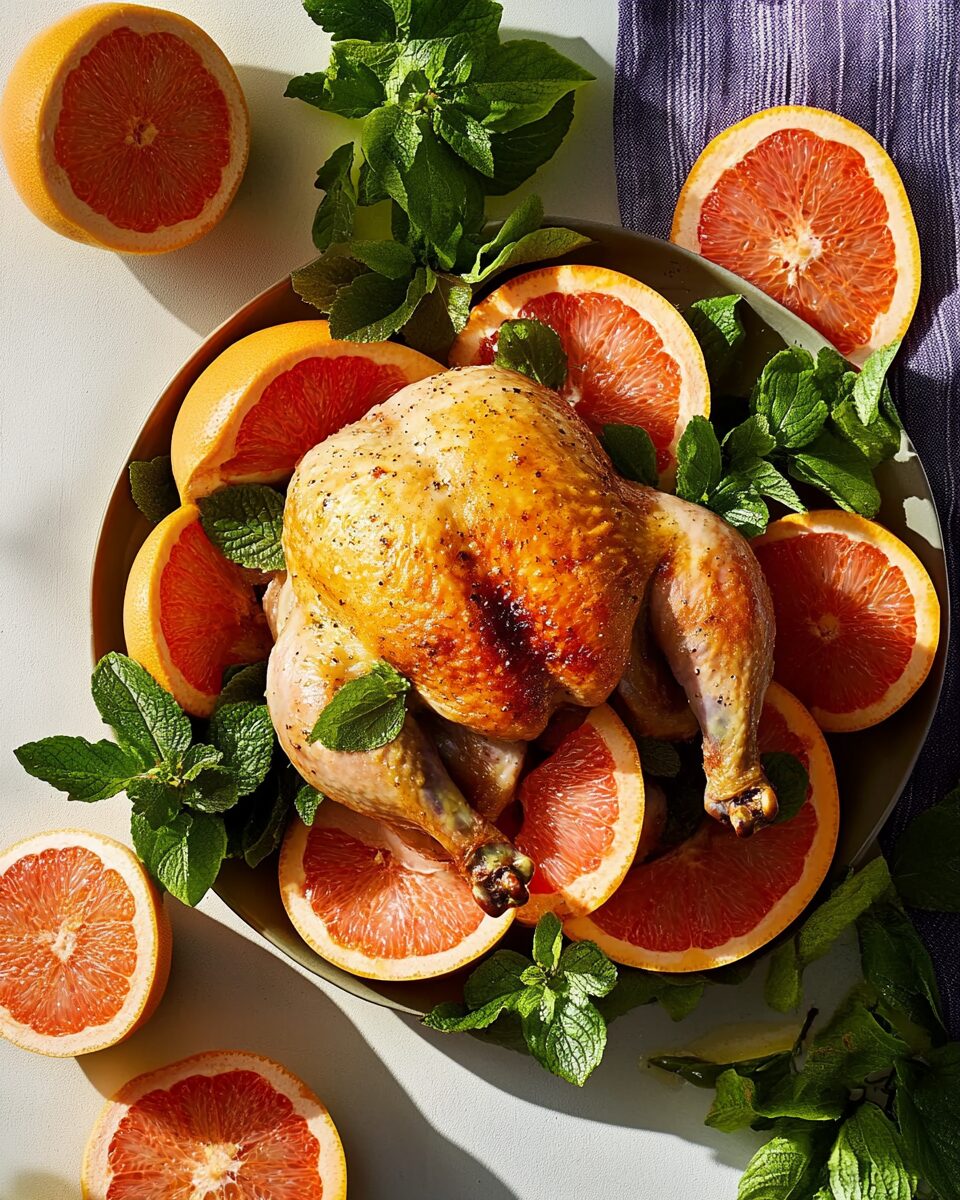This Roast Chicken with Grapefruit is an unexpected yet delicious blend of savory and citrusy flavors. The grapefruit adds a refreshing, tangy note that pairs beautifully with the rich chicken, while the bacon provides a smoky depth. This dish is finished with a flambé sauce made with cognac, adding a touch of elegance to your dinner table.
Perfect for special occasions or a weekend treat, this recipe is sure to impress. The vibrant colors of the grapefruit against the golden-brown roast chicken make it as visually stunning as it is flavorful. This unique twist on classic roast chicken will leave your guests talking about your culinary skills long after the meal is over.
Full Recipe:
- 1 whole chicken
- 2 grapefruits, sectioned into suprêmes, with juice reserved
- Salt and pepper to taste
- A few sprigs of fresh parsley
- 3 strips of bacon, halved
- 1 tablespoon olive oil
- 1/4 cup cognac
- 1/4 cup chicken broth
- 1/4 cup half-and-half
Directions:
- Preheat the oven to 375°F (190°C).
- Section the grapefruits over a bowl to collect the juice, and reserve half of the suprêmes for garnish.
- Combine salt and pepper, then loosen the skin of the chicken by sliding fingers underneath. Rub the salt mixture beneath the skin, inside the cavity, and over the exterior of the chicken.
- Place half of the grapefruit suprêmes and a few parsley sprigs into the chicken cavity. Place the chicken, breast side up, on a rack in a baking dish or cast-iron skillet.
- Secure the legs with kitchen twine, fold the wing tips back, and drape the halved bacon over the chicken breast in a herringbone pattern. Drizzle with olive oil to cover any exposed skin.
- Roast in the preheated oven for 40 minutes, then pour reserved grapefruit juice over the chicken. Continue roasting for an additional 35-40 minutes, or until an instant-read thermometer in the thigh registers 170°F.
- Tent the chicken with foil and let it rest for 15 minutes before serving. Remove and reserve the grapefruit suprêmes from the cavity.
- To make the sauce, warm cognac in a small pan over medium heat until it shimmers. Carefully ignite with a stick lighter or long match and let it burn for about 1 minute.
- Add the reserved roasted grapefruit suprêmes, chicken broth, and half-and-half to the skillet. Heat through and season to taste with salt and pepper.
- Serve the chicken garnished with the remaining fresh grapefruit suprêmes and parsley, drizzled with the warm sauce.
Prep Time: 20 minutes | Cooking Time: 75 minutes | Total Time: 1 hour 35 minutes
Kcal: Approximately 450 kcal per serving | Servings: 4-6 servings
This roast chicken with grapefruit and cognac flambé sauce recipe is a wonderful marriage of rich, savory flavors and refreshing citrus brightness, a combination that elevates the traditional roast chicken to a gourmet experience. It brings together classic elements—crispy-skinned chicken, a hint of smoky bacon, and a touch of fresh herbs—with the unexpected zing of grapefruit. The result is a dish that’s aromatic, visually appealing, and satisfying, ideal for special occasions or simply when you want to indulge in something extraordinary. Here’s a closer look at what makes this dish unique, including some tips for achieving the best flavors, presentation ideas, and suggestions for meal pairing.
The Culinary Appeal of Grapefruit in Savory Dishes
Grapefruit is typically thought of as a breakfast fruit or a component in desserts, yet it has immense potential in savory dishes. Its sharp, zesty flavor, combined with a subtle bitterness, brings a refreshing contrast to rich, fatty meats like chicken, duck, or pork. In this recipe, the grapefruit’s role is multifaceted. First, it flavors the chicken directly, as segments of the fruit are added to the cavity to infuse the meat with subtle citrus notes during roasting. Next, the grapefruit juice is used as a baste midway through the roasting process, enhancing the caramelization on the skin and adding a sticky glaze that’s irresistible.
Using grapefruit in savory dishes also offers a natural sweetness without overwhelming the dish. When roasted, its acidity mellows, and its sugars concentrate, creating a delightful balance. The grapefruit provides both a tang and a depth of flavor, making the roast chicken more layered and complex. This use of citrus is common in Mediterranean and Latin cuisines, where it brightens up meat dishes while adding visual appeal with its vibrant pink or red hues.
Cognac Flambé Sauce: A Touch of Elegance
The flambé technique in cooking brings a touch of drama and sophistication to any dish. In this recipe, cognac flambé is used to create a sauce that’s rich, aromatic, and slightly smoky. By igniting the cognac in the pan, the high alcohol content burns off, leaving behind deep, concentrated flavors that enhance the grapefruit and chicken. Flambé sauces add a memorable experience, infusing the kitchen with a burst of warmth and fragrance that invites everyone to gather around.
Cognac, a type of brandy known for its luxurious depth and warm flavors, is a great choice for this sauce because it complements both the chicken’s richness and the grapefruit’s acidity. The resulting sauce is not only flavorful but also has a smooth, velvety texture, making it the perfect accompaniment to the crispy, juicy chicken. If cognac isn’t available, other types of brandy or even sherry could work, though each will subtly shift the flavor profile.
Tips for the Perfect Roast Chicken Texture and Flavor
Roasting a chicken to perfection is all about balancing moisture, seasoning, and timing. Here are some tips to help achieve the best possible outcome:
- Proper Seasoning: Salt and pepper rubbed both under and over the chicken skin help to ensure the seasoning penetrates the meat, while also aiding in moisture retention.
- Bacon Draping: Placing bacon strips over the breast area in a herringbone pattern offers two benefits: it imparts smoky, savory flavors while protecting the delicate white meat from overcooking. The bacon fat also bastes the chicken as it roasts, contributing to a juicier, more flavorful dish.
- Resting After Roasting: Once the chicken reaches the optimal internal temperature, tent it with foil and allow it to rest. This step helps retain juices, making each slice succulent and tender.
By following these techniques, you’ll achieve a crispy-skinned, golden-brown roast chicken that’s tender and juicy with each bite.
Ideal Occasions for Serving
Roast chicken with grapefruit and flambé cognac sauce is perfect for various occasions, from holiday gatherings to intimate family dinners. Its gourmet appeal, combined with the simplicity of a one-pan dish, makes it versatile yet impressive. The fresh citrusy notes give it a lightness that works beautifully for spring and summer, while the rich flambé sauce adds a depth suitable for fall and winter meals. Whether it’s for a celebratory meal or just a cozy weekend dinner, this recipe is sure to make a memorable impression.
Garnishing and Serving Ideas
When it comes to presentation, this dish is visually striking with the contrasting colors of the caramelized chicken, the vibrant pink grapefruit, and fresh parsley. Here are some ideas to make your dish stand out even more:
- Grapefruit Segments: Serve the roast chicken with fresh grapefruit segments for added visual appeal and bursts of fresh citrus.
- Parsley Sprigs: Adding fresh parsley not only enhances the color but also adds an herbal aroma that balances the dish’s richness.
- Edible Flowers: For a special occasion, consider garnishing with edible flowers that complement the grapefruit’s color palette. This can elevate the presentation, especially for holiday tables or gatherings.
Pairing Suggestions for a Complete Meal
This roast chicken dish pairs beautifully with a variety of side dishes that complement its citrusy, savory profile. Here are a few recommendations to round out the meal:
- Roasted Root Vegetables: Carrots, parsnips, and potatoes roasted with a touch of rosemary or thyme will harmonize with the flavors of the chicken and sauce.
- Wilted Greens: Sautéed spinach or Swiss chard offers a slightly bitter balance, bringing out the dish’s grapefruit notes.
- Grains or Rice: Serve with a pilaf, wild rice, or a creamy polenta to soak up the flavorful sauce.
- White Wine Pairing: A crisp, aromatic white wine, such as Sauvignon Blanc or a dry Riesling, will complement the dish’s citrus and cognac notes beautifully.
Creative Variations and Tips for Customization
One of the best aspects of this recipe is its adaptability. Here are some ways to make it your own:
- Citrus Substitutions: While grapefruit adds a unique flavor, other citrus fruits like oranges or blood oranges can be used for a slightly different taste. These fruits will lend a sweeter, less bitter profile while maintaining the dish’s vibrant acidity.
- Herb Variations: Fresh rosemary, thyme, or sage can be used to vary the herb profile. Each brings a distinct flavor that will pair nicely with the grapefruit and cognac.
- Sauce Alternatives: If you’re not a fan of flambé or don’t have cognac on hand, consider a simpler reduction sauce made with grapefruit juice, chicken broth, and a dash of balsamic vinegar for added depth.
Conclusion
This roast chicken with grapefruit and cognac flambé sauce recipe embodies a creative, flavorful approach to classic comfort food. It combines the timeless appeal of roast chicken with gourmet elements that transform it into a special-occasion dish. From the citrusy brightness of the grapefruit to the elegant depth of the cognac sauce, every component of this recipe has been thoughtfully selected to create a harmonious and memorable dining experience.
Perfect for entertaining or simply treating yourself to a flavorful meal, this recipe is versatile enough to suit a range of dietary preferences and occasions. Its balance of richness and brightness is both satisfying and refreshing, making it a dish you’ll want to come back to again and again. Whether you’re new to cooking with flambé techniques or a seasoned cook looking for an exciting twist, this recipe invites you to explore a sophisticated, yet approachable way to roast chicken.






